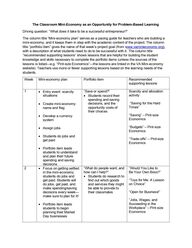
Return to flip book view
The Classroom Mini-Economy as an Opportunity for Problem-Based Learning Driving question: “What does it take to be a successful entrepreneur?” The column title “Mini-economy plan” serves as a pacing guide for teachers who are building a mini-economy, and it keeps them in step with the academic content of the project. The column title “portfolio item” gives the name of that week’s project goal (from www.vaminieconomy.org), with a description of what students need to do to be successful with it. The column title “recommended supporting lessons” shows lessons that are helpful for building the student knowledge and skills necessary to complete the portfolio items (unless the sources of the lessons is listed—e.g. “Pint-size Economics”—the lessons are linked in the VA Mini-economy website). Teachers use more or fewer supporting lessons based on the learning needs of the students. Week Mini-economy plan Portfolio item Recommended supporting lessons 1 • Entry event: scarcity situations • Create mini-economy name and flag • Develop a currency system • Assign jobs • Students do jobs and get paid • Portfolio item leads students to understand and plan their future spending and saving decisions “Save or spend?” • Students record their spending and saving decisions, and the opportunity costs of their choices Scarcity and allocation activity “Saving for the Hard Times” “Saving” – Pint-size Economics “Budgets” – Pint-size Economics “Trade-offs” – Pint-size Economics 2 • Focus on getting settled in the mini-economy; students do jobs and get paid. Students will do jobs, get paid, and make spending/saving decisions every week—make sure to plan for it! • Portfolio item leads students to begin planning their Market Day businesses “What do people want, and how can I help?” • Students do research to find out which goods and services they might be able to provide to their classmates “Would You Like to Be Your Own Boss?” “Toys for Me: A Lesson on Choice” “Open for Business!” “Jobs, Wages, and Succeeding in the Workplace” – Pint-size Economics
• Do an auction or classroom store “Productivity” – Pint-size Economics 3 • The Mini-Economy Portfolio item and its supporting lessons (“Terry’s Lemonade Stand”) require students to use math skills, so teachers must plan adequate time for students to learn and practice these. • Ideally, teachers can use some math time to build necessary skills in this section “How many of our products to people want? • Students do market research to determine the quantities and prices of their products “Terry's Lemonade Stand (Lesson plan for a case study in accounting and graphing)” “Terry's Lemonade Stand (Skit script)” “Terry's Lemonade Stand (Profit accounting sheet)” “Price” ” – Pint-size Economics “Supply and Demand” ” – Pint-size Economics “Profit” ” – Pint-size Economics 4 • Open a classroom “warehouse” from which students can get materials for making their products • Instead of doing a portfolio item, students focus on making their products for the classroom Market Day • Do an auction or classroom store “Do we have the resources we need to make our product?” • Students map out which resources they need for their product. They then find out what other uses a certain resources from their product could have been used for, which demonstrates scarcity “The Productive Blues (Jeans)” “Booker T. Washington: Fifty Cents and a Dream” “Entrepreneur” – Pint-size Economics “Being a Wise Consumer” ” – Pint-size Economics 5 Catch up “Wise Use of Your Money” – Pint-size Economics “Sales and coupons” ” – Pint-size Economics 6-7 • Students continue to work on business products in preparation for classroom Market Day “What should we specialize in?” • Students use the concept of specialization to analyze and modify “Lesson 8: Specialization and Division of Labor” – Playful Economics “Why Do Most People Have a Job Where They
• Class auction or store their production practices Only Make One Good or Service?” “Lean On Me--We Depend On Each Other” “Specialization” ” – Pint-size Economics “Interdependence” – Pint-size Economics 8 • Conduct classroom Market Day • Students debrief • Teacher explains expectations for the big Market Day (e.g. whatever your class’s culminating Market Day event is) “How can we get people to buy our product?” • Students analyze advertisements in order to find ways to communicate persuasively. They make an advertising plan “How Can We Get People to Buy our Product?” “Be an Ad Detective” “Wise Consumers” – Pint-size Economics “Brands and Labels” ” – Pint-size Economics 9 • Students work on producing for the culminating Market Day • Classroom auction or store is optional “Why do different countries produce different things?” • Students investigate how their classroom’s involvement with a big Market Day is like international trade “The Productive Blues (Jeans)” “Booker T. Washington: Fifty Cents and a Dream" “Interdependence” – Pint-size Economics 10 • Go to the big Market Day! Focus is on Market Day! 11 • Reflection and debriefing from the culminating Market Day • Last class auction or store. This one is very important to do, since it gives value to the money students earn at the big Market Day. Failure to do a final auction or store can Summative assignments (media checklist, reflection, peer reflection) Put together your Mini-Economy Business Portfolio! Students should have the opportunity to revise and improve upon their previous portfolio items—remember, a portfolio is about showing mastery!
cause students to take the Market Day less seriously